Introduction: Bridging Eras in the Eternal City

Francesco Trevisani stands as a significant figure in the transition from the grandeur of the Late Baroque to the refined elegance of the Early Rococo in Italian painting. Active primarily in Rome for nearly seven decades, he navigated the complex artistic currents of his time, absorbing influences, developing a distinct style, and leaving a lasting mark on the city's artistic landscape. His long and prolific career saw him rise from a promising provincial artist to one of the most sought-after painters in Rome, favoured by popes, cardinals, and European nobility. Trevisani's work, characterized by its technical finesse, emotional depth, and sophisticated classicism infused with burgeoning Rococo sensibilities, offers a fascinating window into the art world of the late 17th and early 18th centuries.
Early Life and Venetian Foundations
Francesco Trevisani was born in 1656 in Capodistria, Istria, which is now Koper in Slovenia but was then part of the vibrant Republic of Venice. This Venetian origin would subtly inform his artistic sensibilities throughout his career. His initial artistic training came from his father, Antonio Trevisani, who was an architect. This early exposure likely provided him with a foundational understanding of design and composition. However, seeking more formal instruction in painting, the young Francesco moved to Venice itself.
In the bustling artistic centre of Venice, Trevisani entered the studio of Antonio Zanchi. Zanchi was a prominent exponent of the Venetian "tenebroso" style, characterized by dramatic chiaroscuro and robust, often sombre, compositions, drawing heavily on the legacy of painters like Tintoretto. Under Zanchi, Trevisani would have honed his technical skills and absorbed the rich colourism and dynamic energy typical of the Venetian school. While his later Roman work would adopt a more classical polish, the lessons learned in Venice regarding colour, light, and dramatic effect remained underlying elements in his art.
The Move to Rome and the Influence of Maratta
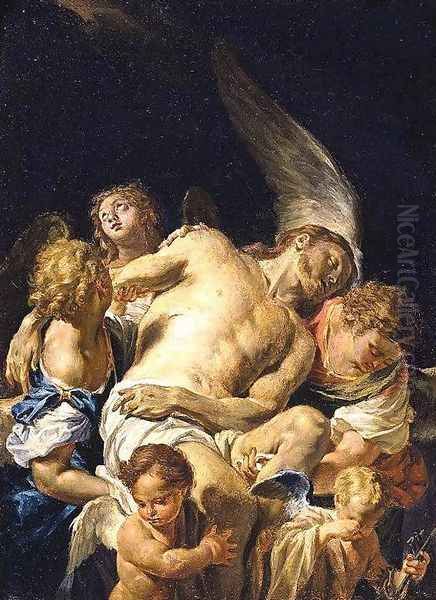
A pivotal moment in Trevisani's career occurred in 1678 when he relocated to Rome. The Eternal City was the undisputed centre of the art world, attracting artists from across Europe. For a young painter with ambition, Rome offered unparalleled opportunities for patronage and exposure to both classical antiquity and the works of the great masters of the Renaissance and Baroque. Upon arriving, Trevisani soon came into the orbit of the dominant figure in Roman painting at the time: Carlo Maratta.
Maratta was the leading proponent of a classical Baroque style, emphasizing clarity, idealized forms, graceful compositions, and a controlled emotional tenor, standing somewhat in contrast to the more exuberant High Baroque. He essentially codified a style that became the benchmark for official taste in Rome. Trevisani became one of Maratta's most important followers, absorbing his teacher's emphasis on draughtsmanship, balanced composition, and refined finish. This influence is clearly visible in Trevisani's work, particularly in the clarity of his narratives and the idealized beauty of his figures.
However, Trevisani was not merely an imitator. He skillfully blended Maratta's classicism with his own Venetian heritage, resulting in a style that possessed both Roman gravitas and a Venetian sensitivity to colour and light. He also began to incorporate a softer, more graceful, and emotionally accessible quality that prefigured the emerging Rococo style.
Developing a Signature Style: Classicism Meets Grace
Throughout the 1680s and 1690s, Trevisani established his reputation in Rome. His style matured, characterized by meticulous technique, smooth brushwork, and a sophisticated handling of light and shadow. While capable of grand compositions, he often excelled at depicting tender or poignant moments, imbuing his religious and historical subjects with a palpable humanity. His figures, though idealized according to classical principles learned from Maratta, often possess a delicate charm and emotional resonance.
His palette, while often grounded in the more subdued tones favoured by the Roman school, could incorporate richer colours, perhaps a lingering echo of his Venetian training. He mastered the art of chiaroscuro, using contrasts of light and dark not just for dramatic effect, as seen in the works of Caravaggio or his teacher Zanchi, but also to create a soft, atmospheric haze that unified his compositions and enhanced their emotional mood. This blend of Maratta's compositional structure, Venetian colour sense, and a unique, gentle sensibility became Trevisani's hallmark.
Major Religious Commissions
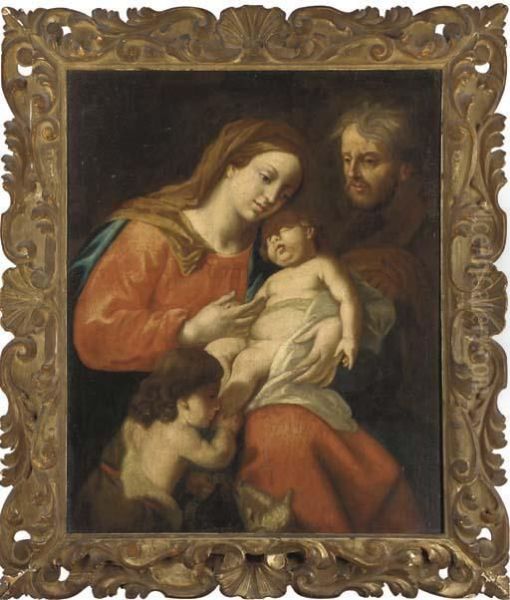
Trevisani's skill and his alignment with the prevailing classical taste brought him significant commissions, particularly from the Church. One of his early major public works was the decoration of the chapel of Santa Chiara in the church of San Silvestro in Capite. Completed between 1695 and 1696, the frescoes depicting scenes from the life of the saint, along with the allegorical figures representing the Four Parts of the World in the vault, showcased his imaginative powers and his ability to handle large-scale narrative compositions. These works demonstrated his mastery of Maratta's style but also hinted at a lighter, more decorative touch.
His reputation grew, leading to patronage at the highest levels. Pope Clement XI became a significant patron, commissioning several important works. For the Duomo (Cathedral) in Urbino, the Pope's hometown, Trevisani contributed paintings. He also worked in one of Rome's most important churches, the Basilica di San Giovanni in Laterano, painting Prophets for the Pope. These prestigious commissions solidified his position as one of Rome's leading painters.
He also received commissions for altarpieces in numerous other Roman churches, contributing significantly to the city's artistic fabric during the late Baroque and early Rococo periods. His ability to convey piety and divine mystery with elegance and technical brilliance made him highly sought after for devotional images.
Masterpieces in Focus: Defining Works
Several paintings stand out as particularly representative of Trevisani's style and achievement. The Martyrdom of Saint Lucy, an earlier work, shows his ability to handle dramatic subjects with compositional clarity and emotional force, still retaining some of the darker, more intense feeling perhaps linked to his Venetian background.
The Death of Saint Joseph is another key work, existing in several versions. These paintings exemplify his mature style: the composition is balanced and clear, the figures are rendered with idealized grace, and the scene is imbued with a quiet, tender pathos. The use of light is masterful, focusing attention on the central figures and creating an atmosphere of solemnity and gentle sorrow. It perfectly captures the blend of classical restraint and nascent Rococo sentiment.
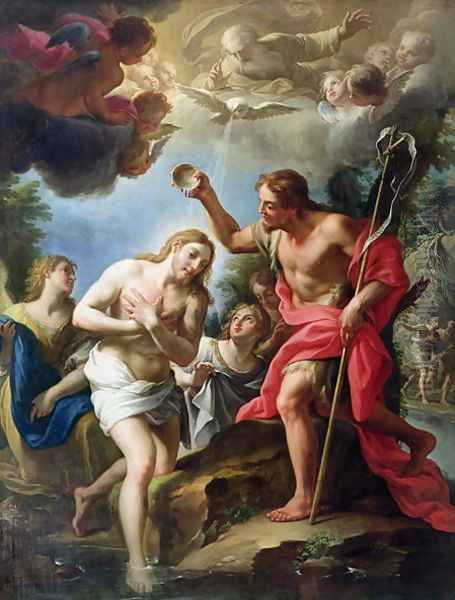
Perhaps his most famous work is the Dead Christ Supported by Angels, now housed in the Kunsthistorisches Museum in Vienna. This painting is a quintessential example of Trevisani's art. The figure of Christ is depicted with anatomical precision yet idealized beauty, reminiscent of classical sculpture. The surrounding angels, rendered with exquisite delicacy and expressing gentle grief, cradle the body. The lighting is soft and focused, highlighting the pale form of Christ against the darker background, creating a powerful image of both suffering and divine peace. The work's emotional resonance and technical perfection made it highly influential. Discussions arose, as they often do with masterpieces, about its sources of inspiration, potentially including classical statuary or the use of live models, highlighting the era's engagement with both tradition and observation.
Trevisani also contributed to major international projects, such as the ambitious decoration of the Mafra National Palace in Portugal, commissioned by King John V. This involvement underscores his international reputation and the reach of the Roman artistic influence during this period.
Portraiture and Patronage
While best known for his religious and historical paintings, Trevisani was also an accomplished portraitist. He painted members of the Roman aristocracy and high clergy, capturing their likenesses with elegance and psychological insight. His portraits often display the same refined technique and sophisticated handling of light seen in his narrative works.
His success was significantly aided by powerful patrons. Cardinal Pietro Ottoboni, a nephew of Pope Alexander VIII, was one of the most important cultural patrons in Rome, known for his lavish support of artists, musicians (including Arcangelo Corelli and Alessandro Scarlatti), and intellectuals. Trevisani became a favoured painter within Ottoboni's circle, receiving numerous commissions and benefiting from the Cardinal's influence. This connection placed Trevisani at the heart of Roman cultural life.
His relationship with other patrons, like the Ruspoli family, for whom he collaborated with artists like Pietro Paolo Cernini and Sebastiano Conca on palace decorations, further cemented his position. The anecdote involving his special attention to the young Francesco Gonzaga, advising him on social graces and gift-giving, illustrates the complex interplay of art, patronage, and social maneuvering within the elite circles of 18th-century Rome. Trevisani was clearly adept not only with the brush but also in navigating these social currents.
The Trevisani Workshop and Legacy
Like most successful artists of his time, Trevisani maintained an active workshop to help manage his numerous commissions. He trained several pupils who went on to have careers of their own. Among his documented students are figures like Francesco Casali, and potentially others such as Lorenzo Masucci (possibly the 'Lorenzo Mazzanti' mentioned in some sources) and Giovanni Battista Brughi (or 'Brati'). Through his students, Trevisani's style and techniques were further disseminated.
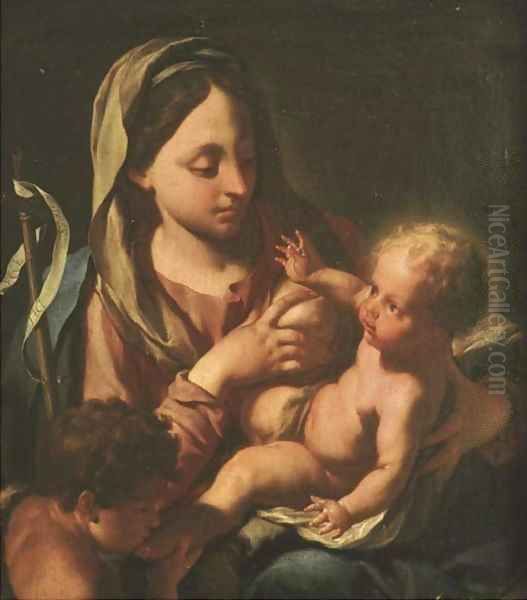
His influence extended beyond his direct pupils. Artists visiting or studying in Rome were exposed to his work. For instance, Pietro Rotari, who later achieved fame as a court painter in Russia, studied in Rome and was influenced by Trevisani's style. Similarly, Claudio Francesco Beaumont, who became court painter in Turin, absorbed aspects of the Roman artistic environment shaped by figures like Trevisani during his time there. Trevisani's work provided a model of refined classicism blended with graceful sentiment that appealed to the evolving tastes of the early 18th century.
Context and Contemporaries
Trevisani worked during a vibrant period in Roman art. While Maratta was the dominant figure when Trevisani arrived, other notable artists were active. Benedetto Luti was a contemporary and sometimes rival, working in a similarly elegant, classicizing vein. Giuseppe Bartolomeo Chiari was another prominent follower of Maratta. Sebastiano Conca, with whom Trevisani sometimes collaborated, developed a highly successful, somewhat more decorative Rococo style.
Looking beyond Rome, Trevisani's career overlapped with the flourishing of the Rococo elsewhere in Italy and Europe. In Venice, artists like Rosalba Carriera were gaining fame for their delicate pastel portraits, and the great Giovanni Battista Tiepolo was beginning his ascent, bringing Venetian colour and light to new heights of Rococo exuberance. In France, Antoine Watteau and later François Boucher were defining the French Rococo. While Trevisani's style remained more grounded in Roman classicism than these figures, his work shares the Rococo's emphasis on grace, elegance, and refined emotion.
His later career saw the emergence of younger artists who would lead the transition towards Neoclassicism, such as Pompeo Batoni. Trevisani's long lifespan meant he witnessed significant shifts in artistic taste, yet he remained a respected figure throughout. His adherence to the principles learned from Maratta, combined with his own gentle sensibility, ensured his work remained relevant even as new styles emerged.
Later Years and Enduring Influence
Francesco Trevisani continued to paint into his old age, remaining active and respected in the Roman art world. He died in Rome in 1746 at the venerable age of 89 or 90, having spent nearly seventy years shaping the city's artistic production. His death marked the end of a long and remarkably consistent career.
His legacy lies in his successful synthesis of Late Baroque classicism with the emerging elegance and emotional sensitivity of the Rococo. He provided a model of technical perfection, compositional harmony, and refined sentiment that influenced a generation of artists in Rome and beyond. His works were widely collected across Europe, finding homes in cities like Munich, Stockholm, Budapest, and Vienna, attesting to his international renown.
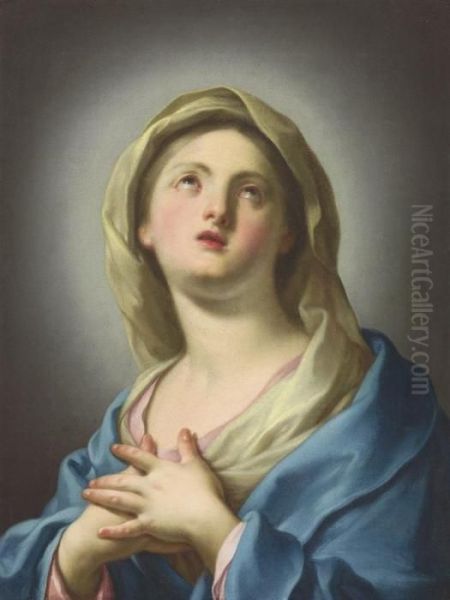
Today, his paintings are held in major museums worldwide, including the Uffizi Gallery in Florence, the Galleria Nazionale d'Arte Antica in Rome, the Louvre in Paris, the National Gallery in London, and the Kunsthistorisches Museum in Vienna. They continue to be admired for their technical mastery, their quiet emotional depth, and their embodiment of the sophisticated artistic taste of early 18th-century Rome. Francesco Trevisani remains a key figure for understanding the complex artistic transitions of his era, a master whose work elegantly bridged the grandeur of the Baroque and the grace of the Rococo.